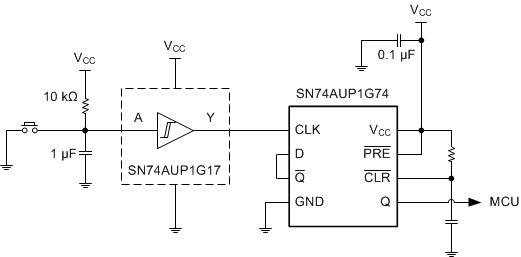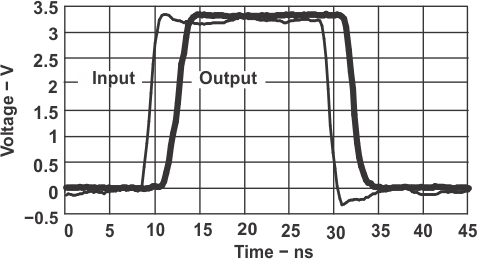SCES644D MARCH 2006 – December 2015 SN74AUP1G74
PRODUCTION DATA.
- 1 Features
- 2 Applications
- 3 Description
- 4 Revision History
- 5 Pin Configuration and Functions
-
6 Specifications
- 6.1 Absolute Maximum Ratings
- 6.2 ESD Ratings
- 6.3 Recommended Operating Conditions
- 6.4 Thermal Information
- 6.5 Electrical Characteristics, TA = 25°C
- 6.6 Electrical Characteristics, TA = -40°C to +85°C
- 6.7 Timing Requirements
- 6.8 Switching Characteristics, CL = 5 pF
- 6.9 Switching Characteristics, CL = 10 pF
- 6.10 Switching Characteristics, CL = 15 pF
- 6.11 Switching Characteristics, CL = 30 pF
- 6.12 Operating Characteristics
- 6.13 Typical Characteristics
- 7 Parameter Measurement Information
- 8 Detailed Description
- 9 Application and Implementation
- 10Power Supply Recommendations
- 11Layout
- 12Device and Documentation Support
- 13Mechanical, Packaging, and Orderable Information
パッケージ・オプション
メカニカル・データ(パッケージ|ピン)
サーマルパッド・メカニカル・データ
発注情報
9 Application and Implementation
NOTE
Information in the following applications sections is not part of the TI component specification, and TI does not warrant its accuracy or completeness. TI’s customers are responsible for determining suitability of components for their purposes. Customers should validate and test their design implementation to confirm system functionality.
9.1 Application Information
The SN74AUP1G74 can be used to control a power button input. Tying Q to D will switch the output between high and low each time that a high signal is sent to CLK from the push button.
A low level at the preset (PRE) or clear (CLR) input sets or resets the outputs, regardless of the levels of the other inputs. When PRE and CLR are inactive (high), data at the data (D) input meeting the setup time requirements is transferred to the outputs on the positive-going edge of the clock pulse. Clock triggering occurs at a voltage level and is not related directly to the rise time of the clock pulse. Following the hold-time interval, data at the D input can be changed without affecting the levels at the outputs.
The resistor and capacitor at the CLR pin are optional. If they are not used, the CLR pin must be connected directly to VCC to be inactive.
9.2 Typical Power Button Circuit
 Figure 5. Device Power Button Circuit
Figure 5. Device Power Button Circuit
9.2.1 Design Requirements
This device uses CMOS technology and has balanced output drive. Take care to avoid bus contention because it can drive currents that would exceed maximum limits. Outputs can be combined to produce higher drive but the high drive will also create faster edges into light loads so routing and load conditions must be considered to prevent ringing.
9.2.2 Detailed Design Procedure
- Recommended Input Conditions:
- For rise time and fall time specifications, see (Δt/ΔV) in Recommended Operating Conditions.
- For specified high and low levels, see (VIH and VIL) in Recommended Operating Conditions.
- Inputs are overvoltage tolerant allowing them to go as high as 4.6 V at any valid VCC.
- Recommend Output Conditions:
- Series resistors on the output may be used if the user desires to slow the output edge signal or limit the output current.
9.2.3 Application Curve

| AUP1G08 data at CL = 15 pF | ||